The content of the article
Who said that a shefler is unpretentious and easy to care for? This man never kept a tropical beauty at home. Sure, she's good. It grows very quickly, lush foliage pleases the eye and warms the soul. True, at home it does not bloom. But this is so small compared to decorativeness.
How to care for a sheflera at home? Carefully and carefully. The slightest deviation from the usual conditions and leaf fall is provided. But do not be scared in advance. It is possible that the rules described below will prove to be a mere trifle for you. Then you should definitely get a shefler.
The most important for the plant are watering, lighting and temperature. Everything else is secondary.
Water for sheflera
Watering. It takes the main place. Very subtle science. If you master it, the sheflera will be infinitely grateful to you. What are the subtleties?
Do not overmoisten the soil. The leaves turn black and fall off. Do not allow the complete drying of an earthen coma. In this case, litter of still green leaves awaits you, but with brown tips. The temperature of the moist earth coma should not fall below + 22 ° C. There should not be a drop of excess water in the pan, but there must be moist claydite or moss.
Water itself is suitable only for standing, and preferably melt. The temperature of the liquid is slightly above room temperature. Shefler needs very high humidity. Therefore, a spray bottle should always be next to it. The procedure is carried out at least 2 times a day, right on the leaves.
For additional moisturizing, water containers are placed nearby, and the batteries are covered with a damp towel.
Tip. If you bought a shefler at a store, wash her leaves at home with laundry soap. For greater decorativeness, it is customary to cover them with wax. They shine, but cannot absorb moisture. In a healthy plant, the leaves themselves will be glossy.
Lighting
Second place in importance. Sheflera needs a lot of light, but direct sunlight is contraindicated to her. Therefore, the window is only western or eastern. In the north, the plant will lose its variegation, if implied. And forms with green foliage are very elongated, fading and turning pale.
The south window gives enough light. But the sun burns the plant, up to complete death. It is either placed on a table or stand near the window, or shaded with a curtain, white paper, cardboard. Still, on the south side, the shefler will be too hot and dry. You will often have to moisten the air.
Temperature
Sheffler feels best of all at a temperature of + 19-23 ° C. But calmly tolerates cooling to + 13 ° C. But warming is fraught with dried tips of leaves or even dropping them.
If the house has air conditioning, then this is to the benefit of the plant. Especially in the summer heat. Just do not put it directly under the stream of air - it categorically does not tolerate drafts.
Tip. In summer, you can take the shefler out onto the street, only at partial shade. It is advisable that the place be closed from the wind.
Pot and soil
What material the pot is made of, the shefler doesn’t care. The main thing is that it fits the size of the root system. It is growing rapidly. For the same reason, the vessel should be free.
At the next transplant, you need to take a pot in diameter 4-7 cm larger than the previous one. This will allow the plant to grow normally.
The soil should be very loose and breathable, but fertile. You can buy in the store a special soil, well suited for palm trees. And you can make the soil yourself. To do this, take in equal shares:
- greasy leaf humus
- peat in large pieces
- clean coarse sand
For better friability, you can add a little foam or coarse eggshell to the mixture, but not necessarily. A thick layer of drainage is laid at the bottom of the container. This is an indispensable condition. Scheffler really does not like stagnation of moisture at the roots, and immediately reacts with decay. Therefore, expanded clay, gravel, marble chips, pebbles - with a layer of at least 4 cm.
Formation
Many refuse to form sheflera, letting it grow on its own. She is growing. In one stalk. Up to 4 meters long. But thin. Her owners tie her up to a peg or a special support, and she still stretches. But the greatest decorativeness can be achieved by simply cutting off the crown of a young plant over 5 leaves. After the appearance of lateral shoots, they are again pinched over 5 leaves. After such a procedure, a lush bush is obtained, and not one long branch.
Tip. Be sure to dust the place with a crushed tablet of activated carbon or fine wood ash to prevent bacteria from entering the open wound.
Diseases and Pests
The most common sheflera disease is rot. She appears from:
- excess moisture in the soil
- temperature too low
- drafts
- overfeeding with fertilizers
- mechanical damage
Avoiding these factors, you can completely avoid the appearance of byaka. If your sheflera began to fade, discard leaves, blacken or get wet - immediately save the plant. First you need to remove the beauty from the pot and carefully examine the root system. Often rot begins there.
A sharp sterile knife or blade cut the damaged areas. Then the roots are kept in a weak solution of potassium permanganate for 20 minutes. And then transplanted into healthy soil.
Pests. In our climate, only three types of insects threaten a shefler: a spider mite, a scabbard and thrips. The first sign of damage is that the plant begins to "cry." That is, juice is dripping from the leaves. So the sheflera is trying to defend herself. You may not see the pests themselves, but you will notice the drops for sure.
Help the plant. Wash the leaves with a warm solution of laundry soap. Just make sure that the mixture does not get into the soil. After that, treat the beauty with any systemic insecticide.
Fertilizers
Sheflera is quite content with any mineral complex fertilizer. It is applied in liquid form after the next watering approximately once in 11-13 days. Once a month, the soil can be sprinkled with finely ground egg shells. But this is only if you did not add it to the ground.
Do not exceed the dosage indicated on the package. This will cause dropping or yellowing of the leaves.
Tip. Use stick or tablet forms of fertilizer whenever possible. Then, when watering, the plant itself will take just as much nutrition as it needs at the moment.
Useful Tips
- Sheflera juice, if it comes into contact with the skin, can cause irritation or dermatitis. Therefore, all manipulations on pinching and transplantation must be performed strictly with gloves. If you have small children or pets, discard this plant. Or put it in a place where it will be difficult to get it.
- Periodically, the leaves of sheflera lose their luster. This comes from dust that accumulates on the surface. It is necessary to wash it in a timely manner with a damp soft cloth. If the plant is already too large, then it is better to arrange a warm shower for him. Only necessarily tightly wrap the pot so that excess liquid does not get there. The pressure of the soul should be weak, otherwise damage to the leaves is possible.
- An adult shefler is transplanted no more than 1 time in 3 years. If you do this every spring, then she will gladly take advantage of your offer and swing it to its natural size. Is there a place for content? Then give her freedom.
- By the way, it is best to transplant the shefler with the transshipment method.That is, without destroying the old earthen coma. If the pot is already too large, then you can not transplant the plant at all. But it is necessary once a year (in spring) to replace the topsoil with a new one. Approximately 7-9 cm.
- Be sure to treat any soil before planting sheflera. A strong solution of potassium permanganate or phytosporin perfectly disinfects purchased or home-made soil. So you can avoid many problems in the future.
- Sheflera does not have a pronounced dormant period, but it must be arranged in the winter so that the plant rests. Since October, stop feeding and reduce watering. The temperature of the contents and lighting do not change. In February, watering is gradually increased again and the plant begins to be fertilized.
How to care for a sheflera at home? As you can see, it’s difficult. But if you wish, all the conditions are completely feasible. Follow the recommendations and the plant will delight you with decorative foliage and powerful growth for a long time.
Video: Sheflera Care

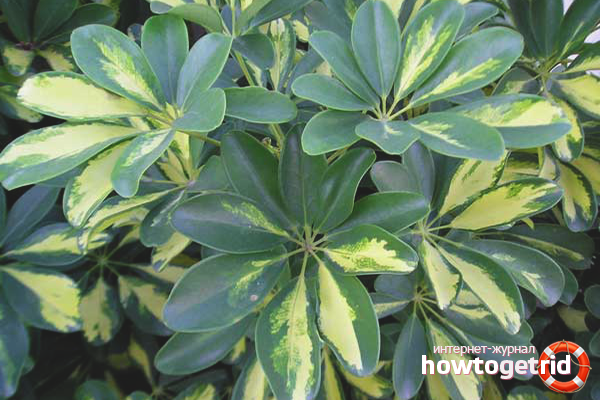

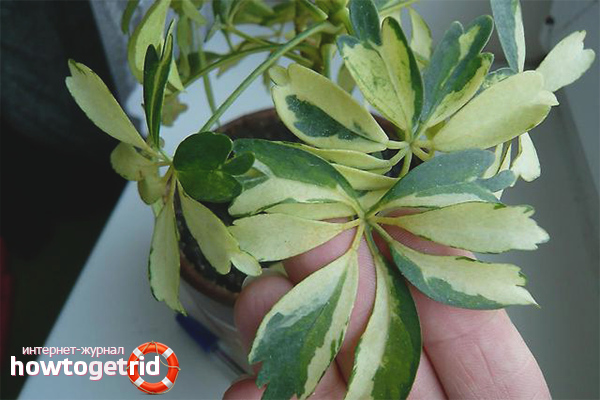
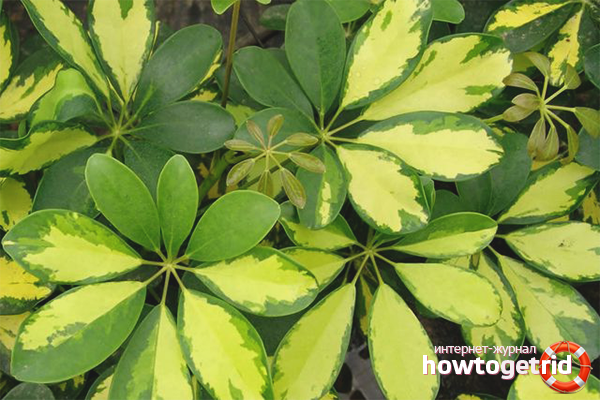
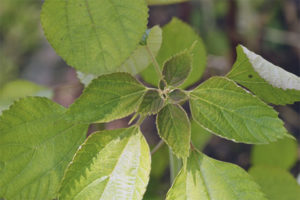


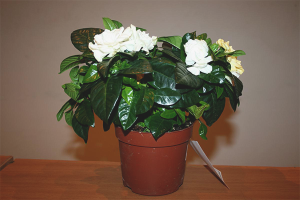
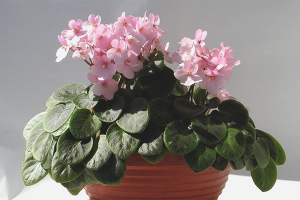



Submit